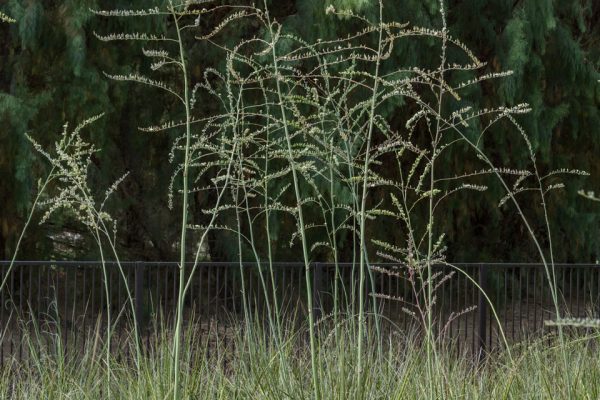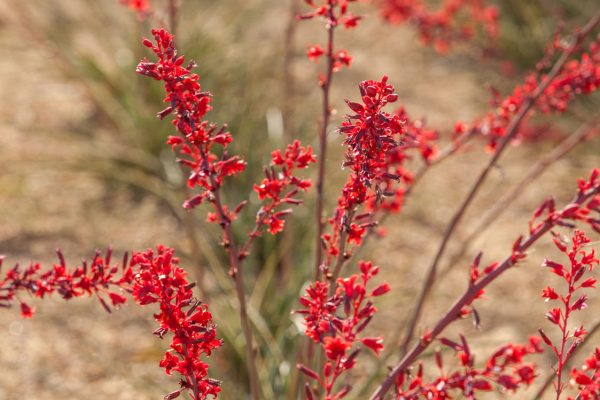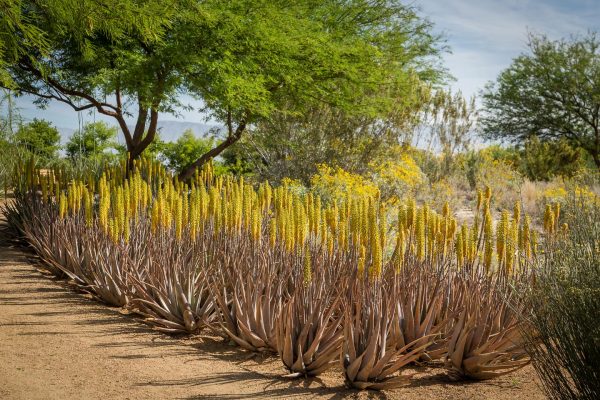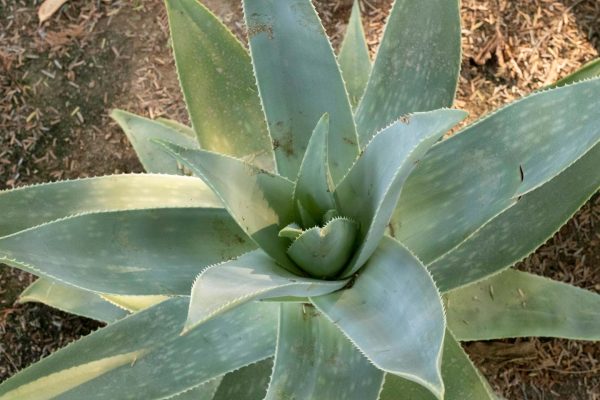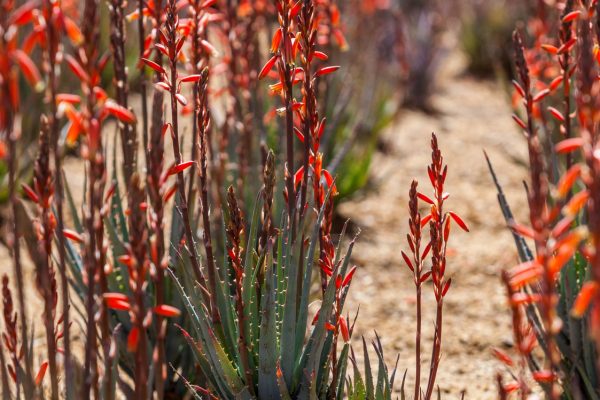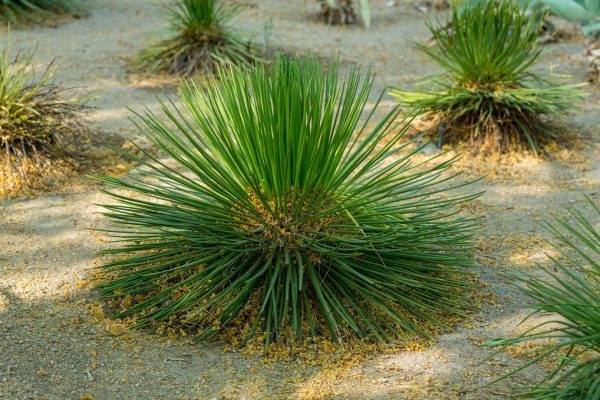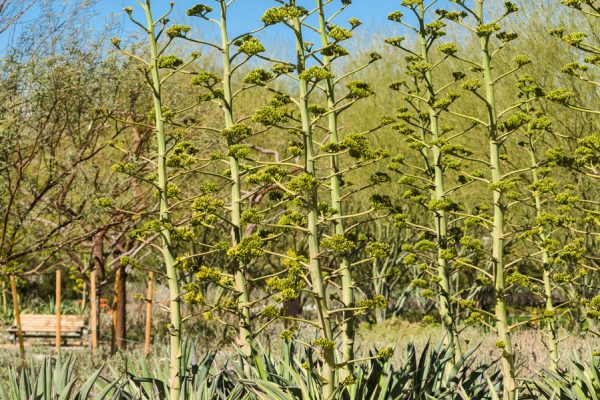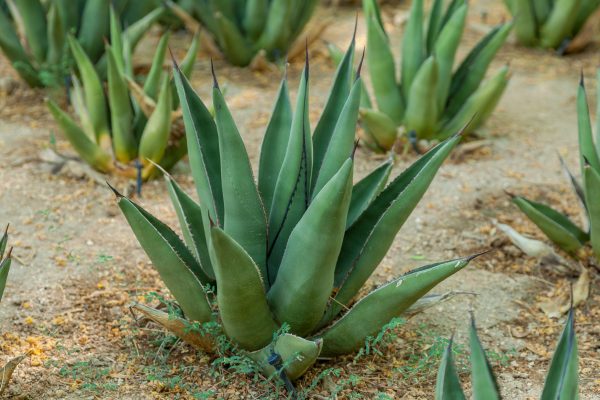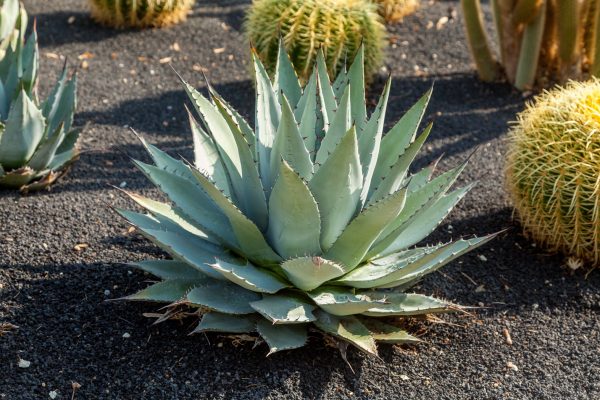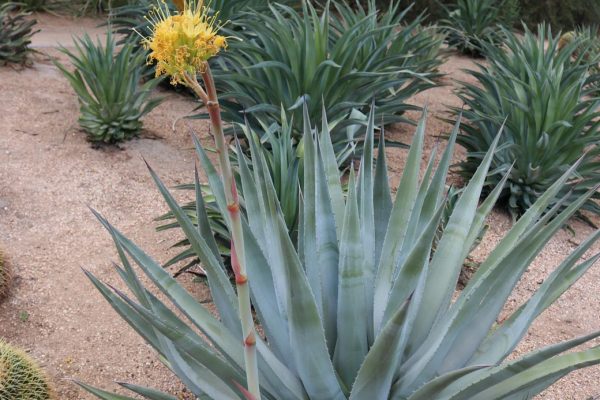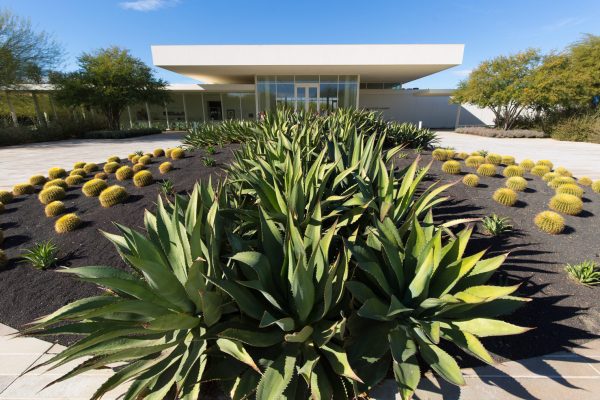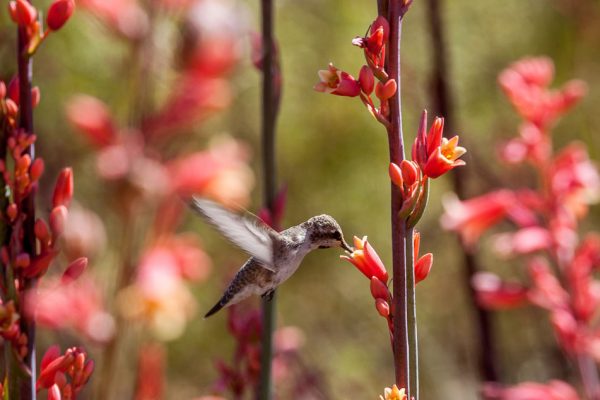
Our medium-sized Hesperaloe is the extremely popular parviflora species, called Red Yucca or Hesperaloe. Due to its easily managed size and beautiful flowers, it is one of the most common Hesperaloes you will see in public garden spaces. Growing up to 4 feet, it develops curving marginal filaments that pull away from the leaf edge, giving the appearance of coarse hair growing off the edges. This makes it easy to distinguish from other rosette-forming succulents.
Red Hesperaloe grows a flowering stalk called a raceme. It can grow to a height of 9 feet, though at Sunnylands it grows normally between 6 and 7 feet, much lower than the 16 foot raceme of its cousin Giant Hesperaloe. Its blooms vary in color through natural garden cross-pollination and human cultivation, but they tend to stay in the dark red to coral pink ranges. This species is a parent of the smaller Hesperaloe called Brakelights, also planted at Sunnylands.
Hesperaloe in general appears to be popular with not only nectaring hummingbirds but also with opportunistic Monarch and Queen Butterfly caterpillars. When Hesperaloe is placed near milkweed beds, chrysalis of both butterflies have been found attached to its leaves. But chrysalis also has been found on agaves, so this is not an identifying feature.

The Giant Hesperaloe is the largest species of the genus Hesperaloe. This giant grows a rosette of crescent-like leaves that reach 6-feet high. For those not familiar with the differing desert genera that grow in a similar style, it can be difficult to distinguish them when not in bloom. Hesperaloe has one helpful indicator for identification, no this pattern is not exclusive to this genus, it helps identify it in these gardens. It is curving marginal filaments that pull away from the leaf edge, giving the appearance of coarse, white hair growing off the edges. If you see those, you then need to determine which species of Hesperaloe you are seeing in the gardens, which is easy. You simply determine, if it is in the 6 foot leaf range and if it is, you are probably looking at the Giant as there are only three species in the gardens, and they fall into the large, medium, and small categories.
Hesperaloe can expand by clumping additional tiny rosettes around the parent plant, as well as setting seed through flowering. They also readily cross-pollinate and hybridize. Giant Hesperaloe displays both pink and white blooming varieties, which grow on a flowering stalk called a raceme. The raceme can reach up to 16 feet. The creamy-white flower is associated with the original funifera species, but the other is a pinkish-toned hybrid. These are both pollinator favorites.
Hesperaloe in general appears to be popular with not only nectaring hummingbirds but also with opportunistic Monarch and Queen Butterfly caterpillars. When Hesperaloe is placed near milkweed beds, chrysalis of both butterflies have been found attached to its leaves. But chrysalis also has been found on agaves, so this is not an identifying feature.

Brakelights is the smallest of the Hesperaloe species at Sunnylands. The term [perpa] in its name means it is a copyrighted variety created through intentional cultivation. From this name, you can probably guess that it was cultivated to accentuate the deepest red variations that have occurred in the parviflora species.
Brakelights has a longer bloom period than its parviflora parent, which is possible because it does not set seed. The additional energy not used in the seed-setting processes allows it to extend its season. It blooms a deep red, but can be tinged with dark purple, making it incredibly striking to see in contrast to the lighter coral and cream blooms of its parent.
Hesperaloe in general appears to be popular with not only nectaring hummingbirds but also with opportunistic Monarch and Queen Butterfly caterpillars. When Hesperaloe is placed near milkweed beds, chrysalis of both butterflies have been found attached to its leaves. But chrysalis also has been found on agaves, so this is not an identifying feature.
Groupings of Medicinal Aloes completely fill their planting beds throughout the gardens as they rapidly produce pups at their base. Growing to heights of 3 feet, their formal structure is effective as both an eye-catching backdrop for some smaller specimens and a front-and-center showstopper along other garden paths.
Medicinal Aloe is particularly striking from January through spring when it blooms in mass. Tall bayonets of yellow flowers create a frenzy of pollinator competition as bees and hummingbirds dodge each other to visit each bloom. The bloom stalks remain in place until all have completed their full cycle through seed setting—communicating that while the Sunnylands garden is an aesthetic garden, laid out with an artistic intent, it also embraces the natural process that allows each plant to complete its cycle.
The origin of Medicinal Aloe is the Arabian Peninsula, but today it is widely propagated around the world for both its aesthetic and medical qualities.
The Ghost Aloe is not a plant from the original landscape plan completed when Sunnylands opened in 2012, but its parent, the Coral Aloe is. Ghost Aloe is a smaller version of Coral Aloe with a tighter rosette. It’s less casual in its structure and has a frosty coloration that gives it the ethereal common name of Ghost.
The blooming structure of this Aloe is not a bayonet appearance like the Medicinal Aloe. It, like Coral Aloe, has a multi-branching stalk topped with a candelabra-type gathering of orange-red flower blooms.

Blue Elf is a small but mighty succulent that can withstand the sun’s full attention on the hot desert floor. The smallest of the aloes at Sunnylands, its clumping nature allows it to spread readily to 2 feet. Visitors will first experience Blue Elf when walking to the front of the Center. It’s found growing in four beds below the Sweet Acacia trees that frame the entrance and anchor the entry circle. It is also on the west side of the gardens where it replaced the less successful Angelita Daisy (Tetraneuris acaulis) from the original 2012 landscape plan. It has proven to be a true powerhouse in the gardens.
The leaves of the aloe sometimes display a pink blush. This is the result of a protection mechanism that helps prevent plant cell sun damage. This response is linked to the storage of the pigment rhodoxanthin in the cells of aloes and can be triggered by environmental stressors, such as low water, but it’s usually seen on plants in full sunlight, which is the other environmental trigger. Planting in shade can reduce the blush, but too much shade may also inhibit its blooms.
Blooming begins annually in January and continues in mass through spring, but other times of the year a single aloe may send up a rogue flower stalk catching visitors’ full attention. Its flower stalk will top out at only 18 inches, displaying red-orange tubular flowers that are the delight of hummingbirds. This easy to grow plant has proven to be most popular with the dozens of Costa’s and Anna’s Hummingbirds that inhabit the gardens.
Reported in North Africa in the Canary and Cape Verde Islands.
Another species that may not be immediately recognizable as an agave is the A. geminiflora. Having attributes including filaments along its margin, instead of teeth, may cause it to be confused with Hesperaloe, which has this similar feature. The leaves are very narrow and flexible. As it grows, a stem will begin to form below its rosette of 200 densely placed, and curved leaves.
The name Twin-flowered or geminiflora describes its paired flower display. Its blooms are yellow with a red flush that grow at the top of a spike that can rise up to 12 feet. This bloom will happen once at end of life. Offsets and bulbils are rare, so propagation is mostly by seed.
Its origin is the Mexican state of Nayarit, with its range at elevations between 3,000 to 4,000 feet. Very susceptible to cold, it needs protection from frost, even in the low desert, but in general can tolerate some shade.
Some Smooth Agave began blooming within a season of their planting. In order to ensure that the Center & Gardens would look established on opening day in 2012, some more mature specimens were used. For the agaves, this meant they would be closer to blooming. The first specimen began to bloom in 2013 and additional ones have continued blooming each year since. This has offered visitors the opportunity to see blooms each season, which is great for the experience but results in the necessity of replacement of individual plants.
The Smooth Agave sends up a thick, branching stalk that blooms bright yellow and then forms bulbils (small, fully formed plants), which can be replanted. Smooth Agave does not exist in the wild but is common in cultivation and its offsets form early, so replanting is not difficult.
It has been found to be cold sensitive and die off of lower leaves immediately after a frost is possible.
Not just a fun name, Sharkskin, with its thick, triangular leaves, is a visually appealing, and sturdy agave. Its name comes from the textural feel of its skin that resembles the feel of shark skin. Described as “stout” or “muscular” due the thickness of its leaf base, it maxes out at 3 feet in height. To some it may look like just another agave, but to those who look for slight variations among varieties, it is distinctive.
Sharkskin is pest resistant. It has proven to be a low maintenance selection at Sunnylands, and due to its lack of a finicky nature, so it does well throughout the gardens.
Its origin is Mexico as a hybrid of A. ferdinandi-regis form of A. victoriae-reginae.

This is the description for Parry’s Agave, but there is also an Agave parryi var. ‘truncata.’ For this variety, please see Artichoke Agave.
The Parry’s Agave is a small, neatly designed variety with elliptical leaves arranged in a tight rosette. It is one of the more common agaves in the garden. It can colonize forming offsets around its base. So, in addition to seed collection, these clones can be collected, and at Sunnylands they are harvested for future specimen replacements. It is a perfect companion for wildflowers and perennials in desert gardens, but is equally successful in groupings of several Parry’s Agave. It is one of the most cultivated species for low-desert gardens.
Parry’s Agave grows an inflorescence (flowering stem) that may rise up to 20 feet, extending branches that will hold bright yellow flowers, touched with red or pink.
It’s origins include Arizona, New Mexico, and the Mexican states of Chihuahua and Durango at an elevation range between 1,500 and 8,000 feet, but it has done equally well on the desert floor. The vast range of this species allows it to thrive in many locations.
The Desert Agave is a medium-sized agave with upright, rigid leaves ending in a strong terminal spine at its tip. It can be found in the lower gardens south of the entry drive, or to the right of the drive if you are standing with your back to the Center.
A local desert native, it is planted throughout the gardens as part of the original landscape design. Gradually rising temperatures in the desert, along with a reduction of winter chills lasting long enough to keep pests at bay, resulted in the struggle of some plants in the first few years. After becoming established, the current Desert Agave specimens are doing well, with some having completed their bloom.
The inflorescence (flowering stalk) can reach up to 13 feet with bright yellow blooms, but this occurs at end of life usually between 15 and 20 years of age, and the plant will die shortly thereafter, leaving the next cross-pollinated generation to move forward.

In front of the Center, in the middle of the motor court, is a medallion-shaped bed where specimens of Cowhorn Agave are arranged among Golden Barrel cactus in a black scoria (lava stone) mulch. The margins of the Cowhorn’s leaves display reddish-brown teeth in a dimorphic (two-style) growth pattern. The teeth are both straight and curved, which results in a “snaggle-toothed” appearance. This is a contrast to some other agaves, which have a somewhat more uniform margin. Cowhorn is also found along the entry drive near the Bob Hope gate, but safe, close-up viewing is best done at the motor court.
This native of Mexico grows wild within an elevation range of 3,000 to 6,000 feet. Cowhorn Agave has not yet bloomed at Sunnylands. It will bloom only once, at end of life—usually between 12 to 18 years. The spike can reach over 20 feet, displaying greenish-yellow flowers.
This species does very well on the desert floor. Though it is more likely to be harmed by frost, it can be light sensitive during high-summer heat.

